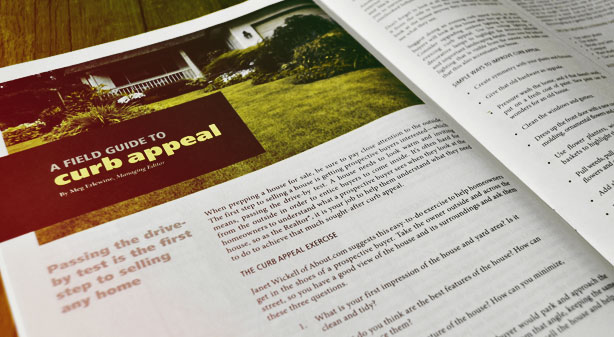A Field Guide to Curb Appeal
 When prepping a house for sale, be sure to pay close attention to the outside. The first step to selling a house is getting prospective buyers interested—which means, passing the drive-by test. A house needs to look warm and inviting from the outside in order to entice buyers to come inside. It’s often hard for homeowners to understand what a prospective buyer sees when they look at the house, so as the Realtor®, it is your job to help them understand what they need to do to achieve that much sought-after curb appeal.
When prepping a house for sale, be sure to pay close attention to the outside. The first step to selling a house is getting prospective buyers interested—which means, passing the drive-by test. A house needs to look warm and inviting from the outside in order to entice buyers to come inside. It’s often hard for homeowners to understand what a prospective buyer sees when they look at the house, so as the Realtor®, it is your job to help them understand what they need to do to achieve that much sought-after curb appeal.
The Curb Appeal Exercise
Janet Wickell of About.com suggests this easy-to-do exercise to help homeowners get in the shoes of a prospective buyer. Take the owner outside and across the street, so you have a good view of the house and its surroundings and ask them these three questions.
- What is your first impression of the house and yard area? Is it clean and tidy?
- What do you think are the best features of the house? How can you enhance them?
- What is the worst feature of the house? How can you minimize, hide or fix this feature?
It’s also good to park where a perspective buyer would park and approach the house from that direction. Note what they see from that angle, keeping the same three things in mind. As a Realtor®, it is your job to sell the house and help the owner to see what needs to be improved in order to do it. Consider running through this exercise prior to taking the homeowner out, so you can be prepared to show them what a potential buyer will see.
Another good exercise is take a few digital photos of the exterior of the house, and compare them both in color and black and white. The absence of color will allow you to narrow in on problem areas that you may have overlooked before.
Don’t forget to look at all approaches to the house—be it from the side or from the rear. Potential buyers will look at the house anyway they can, and it’s essential to see what they see.
Suggest doing an evening curb appeal check, as often buyers will look at the house after they get off of work. Consider upgrading outdoor lighting to improve the evening curb appeal. Use low voltage lighting or decorative lamps to highlight the driveway, sidewalk and important landscaping details. Also note the indoor lighting that is visible from the outside, and make sure that this also accentuates the house.
Simple ways to improve curb appeal
- Create symmetry with your plants and fixtures.
- Give that old hardware an upgrade.
- Pressure wash the home, and if that doesn’t work, put on a fresh coat of paint. New paint can do wonders for an old house.
- Clean the windows and gutters.
- Dress up the front door with a new coat of paint, new molding, ornamental flowers and new hardware.
- Use flower planters, window boxes or hanging baskets to highlight the house.
- Pull weeds, pull over growth and prune the yard. Plant flowers and add new mulch to revitalize the colors.
- Add shutters and accent trim to the windows.
- Replace gutters and downspouts.
- Repair and enhance driveway, by removing cracks, stains and weeds and adding stones or pavers to the side of the driveway.
- Upgrade the porch with new paint and railings.
Sustainable Landscaping
Sustainable landscaping is a philosophy of gardening that balances with the local climate, takes minimal amount of maintenance and reduces your carbon footprint. A sustainable garden is a great solution for trying to spruce up your curb before selling your house. The reason being, ideally your garden will continue to thrive without much work by the new residents. While ultimately you won’t be around to enjoy the fruits of your labors, you don’t want all the work you do to be for naught. When planning your renovations, keep maintenance in mind. And not just yours, but the future owners. A garden that looks like too much upkeep is just as discouraging as a garden that needs a total overhaul.
Tips on creating a sustainable garden
- Use native plants
- Use mulch
- Shrink your lawn
- Compost
- Plant shade trees
- Use local materials
Alternative ground covering to grass
Regular Kentucky Blue grass lawns require a large amount of maintenance, from fertilizers to sprinklers to mowers. But there are many ground covering plants that are good alternatives to grass, requiring less water, are low-growing, spread easily and are draught-resistant. Below is a list of grass alternatives compiled by the Mother Nature Network, who still advises to till the soil and weed before planting, though most are still weed resistant.
- Prairie Zinnia
- Blue Wolly Speedwell
- Showy Snowcrop
- Hardy Yellow Iceplant
- Wooly Thyme
- Native Grass Seed Mixes
- Blue Grama Grass
